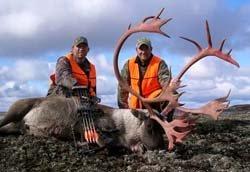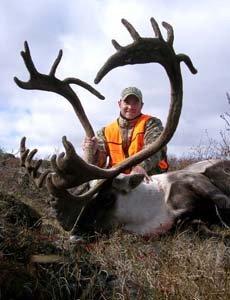Never Quit on Caribou
Hunters: Realtree cameraman Alan Linnenkohl and Bill Miller, host of North American Hunter TV show
Location: Ungava Adventures in northern Quebec 150 miles out of Kuujjuaq, Canada
Species: Caribou
Method: We used a spot and stalk method, taking cover behind rocks and small bushes.
Dates: September 13-18, 2005
Weapon: Alan hunted with a Mathews Switchback bow. Other hunters in camp hunted with guns.
Weather: Temperatures would fall to the teens at night, then would rise into the 50s during the day. It rained a little bit every day and some days it snowed.
Against The Odds
When I got off of the plane, I was surprised by what I saw. From watching caribou hunts on TV, I expected to see numerous trees and a lot of ground cover. We were literally dumped into the Canadian tundra where it was extremely windy with no trees and little vegetation. My first thought was, How in the world am I going to be able to stalk up on these elusive animals without any cover to conceal me?
The other hunters in camp began immediately making fun of me because I brought my bow. Everyone else planned on gun hunting. I was told that we could gun hunt or bow hunt, and I opted to bow hunt. After seeing there reactions, I worried that maybe I had made the wrong decision. I also worried that I would leave the hunt empty handed. With the extreme wind, the lack of cover and my apparent poor choice in a weapon, I feared that the odds were stacked up against me.

We started hunting almost the instant we arrived. That evening we walked a mile or two from our rustic camp through the tundra, which is easier said than done. The rocks were covered in wet moss, which makes for perfect slipping conditions, and water was everywhere.
We basically stalked across the tundra stopping occasionally to glass the landscape. We'd hunker down behind rocks or lay down in little gullies or behind small bushes. Of course, there were no trees, so we were in constant danger of being discovered.
During the first couple days of our hunt, we saw a few caribou at a distance and had one small bull come into range, but it wasn't a shooter.
The wind was blowing so hard that it was all I could do to keep a hat on my head. I had been practicing for this hunt in the 95-degree Georgia weather, and the next thing I know, I'm sitting there in the freezing Canadian wind thinking, How am I going to pull this off? The intense wind and my thick clothes really had me worried, not to mention that the caribou were constantly on the move. Even if I got a shot at a big bull, I worried that he wouldn't slow down long enough for me to make an accurate shot. When we returned from the second day of hunting, I felt certain that I'd leave without a caribou.
A Little Hope Just Over the Hill
On the morning of the third day, when the guides returned from taking some of the other hunters out, they told us that they had spotted a large herd of caribou with numerous bulls a few miles away. One of the guides took us to the location, and as we topped a hill, my heart almost stopped beating in my chest. In front of me stood thousands of caribou. My first instinct was to run into the middle of the herd and shoot one. I was excited and relieved to see this gigantic herd. Finally, I thought, maybe I won't leave empty handed.
Bill Miller, the guide and I glassed the caribou with our binoculars. Bill picked out the bull he wanted, and we set up on it, but it ended up bedding down before he could get off a shot. So, he decided to try for another one. With that many caribou, you wouldn't think it would be so hard to sneak up on one, but it's very easy for the cows to wind you. Once they catch whiff of human sent, they'll push away from you leading the bulls in another direction.
When there was a break in the travel of the caribou, we'd slip from rock to rock or from bush to bush. When we finally got close enough to the herd, we waited and waited until a really nice bull approached. As soon as he was within range, Bill shot and killed him.
Dashing and Diving
After he took his caribou, we moved out several hundred yards and started glassing for another bull. We had to move numerous times to get set up on a group of them. They were very observant and not easily fooled. At the guide's command, I'd run a 100-yard dash, drop behind a bush, knock an arrow and wait as I caught my breath.
After dashing and diving behind rocks again and again, I finally got close to a group of bulls. My guide told me to knock an arrow and get ready. He held me off as the first bull passed by telling me that a large one was approaching. When I saw that larger bull, my heart pounded in my chest. He was really big. When he got within 28 yards of me, I stood up, drew my bow, aimed and made a kill shot. He ran approximately 100 yards and dropped. I was elated. I had finally done it -- I had finally taken my first caribou. I wouldn't have to return home empty handed!
When I reached him, I couldn't believe his immense size. He was a monster. Even though we didn't measure him, my guide said he would definitely meet Pope & Young standards. I was very excited, not only to have taken a caribou, but because I knew that my hunt was not over. I had two tags with one left to fill. I felt so relieved. Everyone was skeptical of me killing one with a bow with the horrible wind and weather conditions, and I proved them wrong. I had two more days of hunting, and I was ready to get started.
'Bou Part II
The next day wasn't too eventful. The HD camera used to film North American Hunter TV show went down in the rain. We put our hunt on hold until they had one flown in from Montreal on a float plane.

We were up and running that next day. Bill, my guide, the cameramen and I returned to the area where we had harvested our bulls. Almost immediately we located another good bull. All I can remember is running as fast as I could and ducking down behind a few small bushes and some rocks. A couple of cows came by me at 30 yards. Since the bulls usually follow the cows, I felt confident that I'd get a 30-yard shot at a bull.
Since there were five people in our group, my guide suggested that I move closer to the caribou away from the other guys in fear that they'd spot us. He told me he'd let me know when to stand up and draw. So, I inched closer to the caribou. When he gave me the command, I stood up, drew my bow and realized that the huge, shooter bull was 53 yards away. The guide whistled to stop him, and the cameraman said, I'm on him, so I knew it was left up to me. I got extremely nervous all of the sudden. I worried about the distance and the wind, but I made the shot and it was good! I hit him dead on, and he took off running with the herd. He ran up over a hill and crashed on a big rock outcropping that extended into a lake.
He was bigger than the first caribou I shot. Both of them had double shovels, which the guide informed me was extremely rare. Even though I started out the hunt a little skeptical, I ended up having an awesome time. I learned on that hunt not to give up hope. You never know what the next minute will bring.
I owe my success to my guide as well as to the new Advantage MAX-1 HD pattern. The light colors and openness of the pattern blended in perfectly with the open tundra. The all-terrain pattern offers the perfect color scheme for any type of hunting in sparse, open landscapes.
Ungava Adventures
Ungava Adventures is an established, reputable and reliable operation with a proven track record. Acclaimed in numerous outdoor magazines and featured regularly on outdoor channels.
Ungava Adventures prides itself on providing the quality fishing and hunting opportunities in the Ungava region of arctic Quebec. Whether you wish to challenge the majestic caribou on the open tundra, the elusive black bear of the interior or discover a nest of fighting brookies, silver-backed Atlantic salmon and giant lake trout in some nameless lake or river -- Ungava Adventures stands ready to deliver your dreams.
He was bigger than the first caribou I shot. Both of them had double shovels, which the guide informed me was extremely rare.
In continuous operation for more than 25 years, Ungava Adventures controls the most exclusive outfitting areas in Arctic Quebec. In addition to operating in zone 23, Ungava also has secured outfitting rights on game-rich, native-controlled lands from the communities of Kuujjuaq, Apaluk and Kangiqsualujjuaq. Within a 400,000 square mile region, the outfitter operates 14 separate comfortable camps offering the very best fishing and hunting available in northern Quebec.
The season extends from late July to late August for fishing and mid-August to early October for caribou. In addition to Arctic operations, Ungava conducts a spring bear hunt from late May to the end of June. Due to the relatively short season and limited occupancy -- early reservations are strongly recommended.
For more information, call 800-567-9306 or 819-477-4747, or check out www.ungava-adventures.com.







